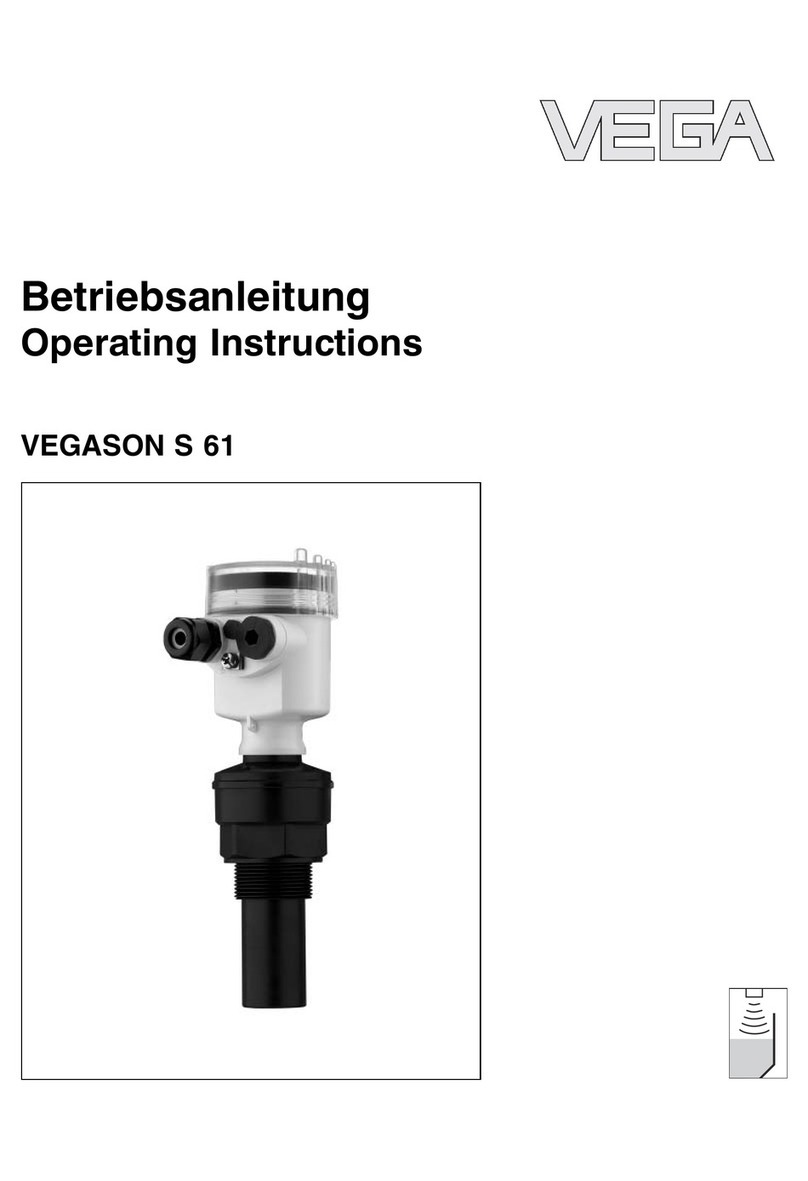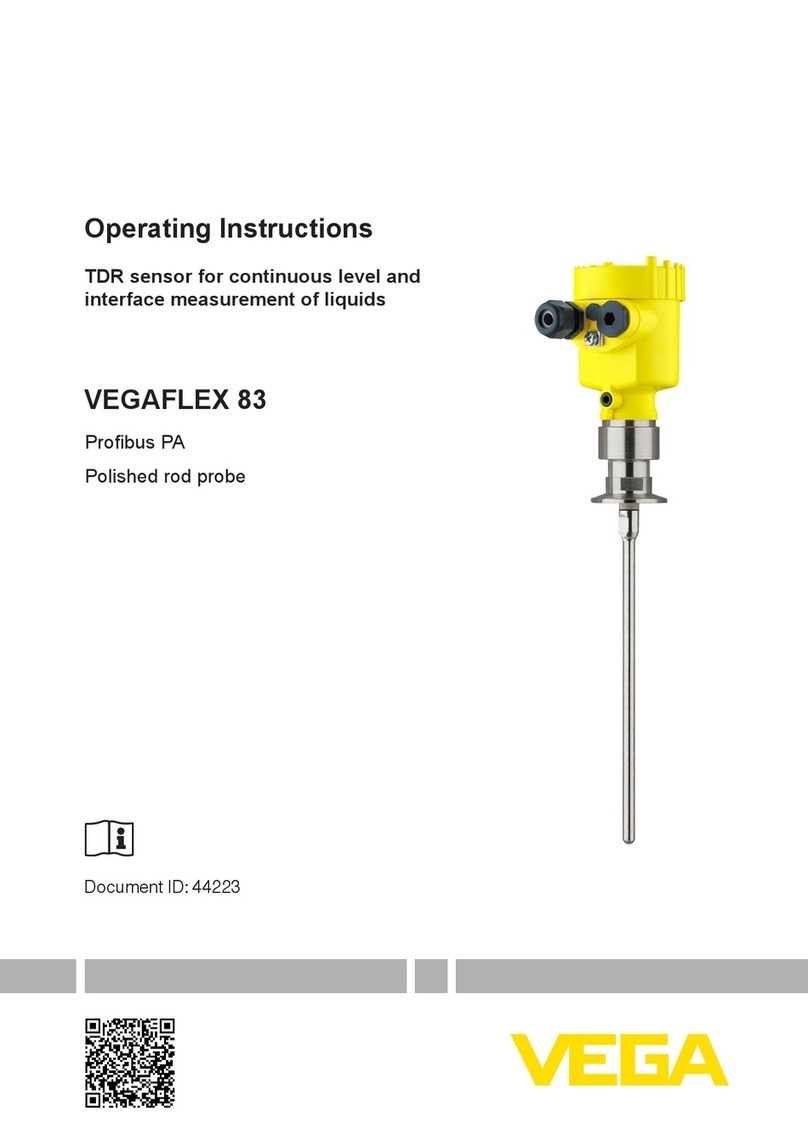Vega VEGAPULS 62 User manual

Operating Instructions
Radar sensor for continuous level
measurement of liquids
VEGAPULS 62
4 … 20 mA/HART - four-wire
Approval according to LPR radio standard
Document ID: 41719

2
Contents
VEGAPULS 62 • 4 … 20 mA/HART - four-wire
41719-EN-161104
Contents
1 About this document
1.1 Function ........................................................................................................................... 4
1.2 Target group ..................................................................................................................... 4
1.3 Symbols used................................................................................................................... 4
2 For your safety
2.1 Authorised personnel ....................................................................................................... 5
2.2 Appropriate use................................................................................................................ 5
2.3 Warning about incorrect use............................................................................................. 5
2.4 General safety instructions............................................................................................... 5
2.5 EU conformity................................................................................................................... 6
2.6 NAMUR recommendations .............................................................................................. 6
2.7 Radio license for Europe .................................................................................................. 6
2.8 Environmental instructions ............................................................................................... 7
3 Product description
3.1 Conguration.................................................................................................................... 8
3.2 Principle of operation........................................................................................................ 9
3.3 Packaging, transport and storage..................................................................................... 9
3.4 Accessories and replacement parts ............................................................................... 10
4 Mounting
4.1 General instructions ....................................................................................................... 12
4.2 Mounting preparations ................................................................................................... 13
4.3 Mounting instructions ..................................................................................................... 15
4.4 Measurement setup - Pipes ........................................................................................... 20
4.5 Measurement setup - Flow............................................................................................. 25
5 Connecting to power supply
5.1 Preparing the connection ............................................................................................... 27
5.2 Connecting..................................................................................................................... 28
5.3 Wiring plan, double chamber housing ............................................................................ 30
5.4 Double chamber housing with DISADAPT ..................................................................... 31
5.5 Switch-on phase............................................................................................................. 32
6 Set up with the display and adjustment module
6.1 Insert display and adjustment module............................................................................ 33
6.2 Adjustment system......................................................................................................... 34
6.3 Measured value indication - Selection national language............................................... 35
6.4 Parameter adjustment .................................................................................................... 36
6.5 Saving the parameter adjustment data........................................................................... 53
7 Setup with PACTware
7.1 Connect the PC.............................................................................................................. 54
7.2 Parameter adjustment .................................................................................................... 55
7.3 Saving the parameter adjustment data........................................................................... 56
8 Set up with other systems
8.1 DD adjustment programs ............................................................................................... 57
8.2 Field Communicator 375, 475 ........................................................................................ 57
9 Diagnosis, asset management and service
9.1 Maintenance .................................................................................................................. 58

3
Contents
VEGAPULS 62 • 4 … 20 mA/HART - four-wire
41719-EN-161104
9.2 Measured value and event memory ............................................................................... 58
9.3 Asset Management function........................................................................................... 59
9.4 Rectify faults................................................................................................................... 62
9.5 Exchanging the electronics module................................................................................ 66
9.6 Software update ............................................................................................................. 67
9.7 How to proceed if a repair is necessary.......................................................................... 67
10 Dismount
10.1 Dismounting steps.......................................................................................................... 68
10.2 Disposal ......................................................................................................................... 68
11 Supplement
11.1 Technical data ................................................................................................................ 69
11.2 Radio astronomy stations............................................................................................... 77
11.3 Dimensions .................................................................................................................... 78
11.4 Industrial property rights................................................................................................. 83
11.5 Trademark ...................................................................................................................... 83
Safety instructions for Ex areas
TakenoteoftheExspecicsafetyinstructionsforExapplications.
These instructions are attached as documents to each instrument
with Ex approval and are part of the operating instructions manual.
Editing status: 2016-10-19

4
1 About this document
VEGAPULS 62 • 4 … 20 mA/HART - four-wire
41719-EN-161104
1 About this document
1.1 Function
This operating instructions manual provides all the information you
need for mounting, connection and setup as well as important instruc-
tionsformaintenanceandfaultrectication.Pleasereadthisinforma-
tion before putting the instrument into operation and keep this manual
accessible in the immediate vicinity of the device.
1.2 Target group
This operating instructions manual is directed to trained specialist
personnel.The contents of this manual should be made available to
these personnel and put into practice by them.
1.3 Symbols used
Information, tip, note
This symbol indicates helpful additional information.
Caution: If this warning is ignored, faults or malfunctions can result.
Warning: If this warning is ignored, injury to persons and/or serious
damage to the instrument can result.
Danger: If this warning is ignored, serious injury to persons and/or
destruction of the instrument can result.
Ex applications
This symbol indicates special instructions for Ex applications.
• List
The dot set in front indicates a list with no implied sequence.
→ Action
This arrow indicates a single action.
1 Sequence of actions
Numbers set in front indicate successive steps in a procedure.
Battery disposal
This symbol indicates special information about the disposal of bat-
teries and accumulators.

5
2 For your safety
VEGAPULS 62 • 4 … 20 mA/HART - four-wire
41719-EN-161104
2 For your safety
2.1 Authorised personnel
All operations described in this operating instructions manual must
be carried out only by trained specialist personnel authorised by the
plant operator.
During work on and with the device the required personal protective
equipment must always be worn.
2.2 Appropriate use
VEGAPULS 62 is a sensor for continuous level measurement.
Youcannddetailedinformationabouttheareaofapplicationin
chapter "Product description".
Operational reliability is ensured only if the instrument is properly
usedaccordingtothespecicationsintheoperatinginstructions
manual as well as possible supplementary instructions.
2.3 Warning about incorrect use
Inappropriate or incorrect use of the instrument can give rise to
application-specichazards,e.g.vesseloverllordamagetosystem
components through incorrect mounting or adjustment. Also the pro-
tectivecharacteristicsoftheinstrumentcanbeinuenced.
2.4 General safety instructions
This is a state-of-the-art instrument complying with all prevailing
regulations and guidelines. The instrument must only be operated in a
technicallyawlessandreliablecondition.Theoperatorisresponsible
for the trouble-free operation of the instrument.
During the entire duration of use, the user is obliged to determine the
compliance of the necessary occupational safety measures with the
current valid rules and regulations and also take note of new regula-
tions.
The safety instructions in this operating instructions manual, the na-
tional installation standards as well as the valid safety regulations and
accident prevention rules must be observed by the user.
For safety and warranty reasons, any invasive work on the device
beyond that described in the operating instructions manual may be
carried out only by personnel authorised by the manufacturer. Arbi-
traryconversionsormodicationsareexplicitlyforbidden.
The safety approval markings and safety tips on the device must also
be observed.
Depending on the instrument version, the emitting frequencies are in
the C, K or W band range. The low emitting frequencies are far below
the internationally approved limit values.When used correctly, the
device poses no danger to health.

6
2 For your safety
VEGAPULS 62 • 4 … 20 mA/HART - four-wire
41719-EN-161104
2.5 EU conformity
ThedevicefullsthelegalrequirementsoftheapplicableEUguide-
lines.ByaxingtheCEmarking,weconrmtheconformityofthe
instrument with these guidelines.
YoucanndtheEUconformitydeclarationonourwebsiteunder
www.vega.com/downloads.
Electromagnetic compatibility
Instruments in four-wire or Ex-d-ia version are designed for use in an
industrial environment. Nevertheless, electromagnetic interference
from electrical conductors and radiated emissions must be taken into
account, as is usual with class A instruments according to EN 61326-
1.Iftheinstrumentisusedinadierentenvironment,theelectromag-
netic compatibility to other instruments must be ensured by suitable
measures.
2.6 NAMUR recommendations
NAMUR is the automation technology user association in the process
industry in Germany. The published NAMUR recommendations are
acceptedasthestandardineldinstrumentation.
ThedevicefullstherequirementsofthefollowingNAMURrecom-
mendations:
• NE 21 – Electromagnetic compatibility of equipment
• NE 43 – Signal level for malfunction information from measuring
transducers
• NE53–Compatibilityofelddevicesanddisplay/adjustment
components
• NE107–Self-monitoringanddiagnosisofelddevices
For further information see www.namur.de.
2.7 Radio license for Europe
The instrument was tested according to the latest issues of the har-
monizedstandards:
• EN 302372 - Tank Level Probing Radar
• EN 302729 - Level Probing Radar
It is hence approved for use inside and outside closed vessels in
countries of the EU.
In EFTA countries, the use is approved as far as these standards
were implemented.
For operation inside of closed vessels, the following conditions must
befullled:
• The instrument must be permanently mounted on a closed vessel
made of metal, reinforced concrete, or comparable attenuating
materials
• Flanges,processttingsandmountingaccessoriesmustensure
the microwave impermeability of the vessel and not let the radar
signal escape to the outside

7
2 For your safety
VEGAPULS 62 • 4 … 20 mA/HART - four-wire
41719-EN-161104
• If necessary, existing viewing windows in the vessel must be
coated with a microwave impermeable material (e.g. electrically
conductive coating)
• Manholesandangesonthevesselmustbeclosedandsealedto
avoid penetration of the radar signal
• The instrument should be preferably mounted on top of the vessel
with antenna orientation downward
• The instrument must only be installed and maintained by appropri-
atelyqualiedsta
For operation outside of closed vessels, the following conditions must
befullled:
• Theinstallationmustbecarriedoutbytrainedqualiedpersonnel
• The instrument must be stationary mounted and the antenna
directed vertically downward
• The mounting location must be at least 4 km away from radio
astronomy stations, unless special permission was granted by the
responsible national approval authority
• When installed within 4 to 40 km of a radio astronomy station,
the instrument must not be mounted higher than 15 m above the
ground.
Youcanndalistoftherespectiveradioastronomystationsinchap-
ter "Supplement".
2.8 Environmental instructions
Protection of the environment is one of our most important duties.
That is why we have introduced an environment management system
with the goal of continuously improving company environmental pro-
tection.Theenvironmentmanagementsystemiscertiedaccording
to DIN EN ISO 14001.
Pleasehelpusfullthisobligationbyobservingtheenvironmental
instructions in this manual:
• Chapter "Packaging, transport and storage"
• Chapter "Disposal"

8
3 Product description
VEGAPULS 62 • 4 … 20 mA/HART - four-wire
41719-EN-161104
3 Product description
3.1 Conguration
Thetypelabelcontainsthemostimportantdataforidenticationand
use of the instrument:
2
1
15
13
14
12
11
5
3
6
4
7
8
10
9
Fig. 1: Layout of the type label (example)
1 Instrument type
2 Product code
3 Approvals
4 Power supply and signal output, electronics
5 Protection rating
6 Measuring range
7 Process and ambient temperature, process pressure
8 Material, wetted parts
9 Hardware and software version
10 Order number
11 Serial number of the instrument
12 Data matrix code for smartphone app
13 Symbol of the device protection class
14 ID numbers, instrument documentation
15 Reminder to observe the instrument documentation
The type label contains the serial number of the instrument. With it
youcanndthefollowinginstrumentdataonourhomepage:
• Product code (HTML)
• Delivery date (HTML)
• Order-specicinstrumentfeatures(HTML)
• Operating instructions and quick setup guide at the time of ship-
ment (PDF)
• Order-specicsensordataforanelectronicsexchange(XML)
• Testcerticate(PDF)-optional
Go to "www.vega.com", "VEGA Tools" and "Instrument search". Enter
the serial number.
Alternatively, you can access the data via your smartphone:
• Download the smartphone app "VEGA Tools" from the "Apple App
Store" or the "Google Play Store"
• Scan the Data Matrix code on the type label of the instrument or
• Enter the serial number manually in the app
Type label
Serial number - Instru-
ment search

9
3 Product description
VEGAPULS 62 • 4 … 20 mA/HART - four-wire
41719-EN-161104
This operating instructions manual applies to the following instrument
versions:
• Hardware from 1.0.0
• Software from 4.4.0
The scope of delivery encompasses:
• Radar sensor
• Documentation
– Quick setup guide VEGAPULS 62
– Instructions for optional instrument features
– Ex-specic"Safety instructions" (with Ex versions)
– Ifnecessary,furthercerticates
• DVD "DTM Collection", included therein
– PACTwa re
– DTM Collection
– Instrumentmasterles(GSD)forProbusPA
– FDTcerticates
Information:
In the operating instructions manual, the optional instrument features
are described.The respective scope of delivery results from the order
specication.
3.2 Principle of operation
The VEGAPULS 62 radar sensor can be used in a wide variety of ap-
plications for continuous level measurement of liquids. It is suitable for
applications in storage vessels, reactors and process vessels, even
underextremelydicultprocessconditions.
The instrument is ideal also for all applications in the water and waste
water industry. It is particularly suitable for level measurement in water
treatment,inpumpstationsaswellasstormwateroverowtanks,for
owmeasurementinopenumesandforgaugemeasurement.
The antenna of the radar sensor emits short radar pulses with a
durationofapprox.1ns.Thesepulsesarereectedbytheproduct
and received by the antenna as echoes. The transit time of the radar
pulses from emission to reception is proportional to the distance and
hence to the level.The determined level is converted into an appropri-
ate output signal and outputted as measured value.
3.3 Packaging, transport and storage
Your instrument was protected by packaging during transport. Its
capacity to handle normal loads during transport is assured by a test
based on ISO 4180.
The packaging of standard instruments consists of environment-
friendly, recyclable cardboard. For special versions, PE foam or PE
foil is also used. Dispose of the packaging material via specialised
recycling companies.
Scope of this operating
instructions manual
Scope of delivery
Application area
Functional principle
Packaging

10
3 Product description
VEGAPULS 62 • 4 … 20 mA/HART - four-wire
41719-EN-161104
Transport must be carried out in due consideration of the notes on the
transport packaging. Nonobservance of these instructions can cause
damage to the device.
The delivery must be checked for completeness and possible transit
damage immediately at receipt. Ascertained transit damage or con-
cealed defects must be appropriately dealt with.
Up to the time of installation, the packages must be left closed and
stored according to the orientation and storage markings on the
outside.
Unless otherwise indicated, the packages must be stored only under
the following conditions:
• Not in the open
• Dry and dust free
• Not exposed to corrosive media
• Protected against solar radiation
• Avoiding mechanical shock and vibration
• Storage and transport temperature see chapter "Supplement -
Technical data - Ambient conditions"
• Relative humidity 20 … 85 %
3.4 Accessories and replacement parts
The display and adjustment module PLICSCOM is used for measured
value indication, adjustment and diagnosis. It can be inserted into the
sensor and removed at any time.
Youcanndfurtherinformationintheoperatinginstructions"Display
and adjustment module PLICSCOM" (Document-ID 27835).
The interface adapter VEGACONNECT enables the connection of
communication-capable instruments to the USB interface of a PC. For
parameter adjustment of these instruments, the adjustment software
PACTware with VEGA-DTM is required.
Youcanndfurtherinformationintheoperatinginstructions"Interface
adapter VEGACONNECT" (Document-ID 32628).
The VEGADIS 81 is an external display and adjustment unit for VEGA
plics®sensors.
For sensors with double chamber housing the interface adapter
"DISADAPT" is also required for VEGADIS 81.
Youcanndfurtherinformationintheoperatinginstructions
"VEGADIS 81" (Document-ID 43814).
The VEGADIS adapter is an accessory part for sensors with double
chamber housings. It enables the connection of VEGADIS 81 to the
sensor housing via an M12 x 1 plug.
Youcanndfurtherinformationinthesupplementaryinstructions
"VEGADIS adapter" (Document-ID 45250).
Transport
Transport inspection
Storage
Storage and transport
temperature
PLICSCOM
VEGACONNECT
VEGADIS 81
VEGADIS adapter

11
3 Product description
VEGAPULS 62 • 4 … 20 mA/HART - four-wire
41719-EN-161104
VEGADIS 82 is suitable for measured value indication and adjustment
of sensors with HART protocol. It is looped into the 4 … 20 mA/HART
signal cable.
Youcanndfurtherinformationintheoperatinginstructions
"VEGADIS 82 4 … 20 mA/HART" (Document-ID 45300).
PLICSMOBILE T61 is an external GSM/GPRS radio unit for transmis-
sion of measured values and for remote parameter adjustment of
plics®sensors. Adjustment is carried out via PACTware/DTM and the
integrated USB connection.
Youcanndfurtherinformationinthesupplementaryinstructions
"PLICSMOBILE T61" (Document-ID 37700).
The protective cover protects the sensor housing against soiling and
intense heat from solar radiation.
Youwillndadditionalinformationinthesupplementaryinstructions
manual "Protective cover" (Document-ID 34296).
Screwedangesareavailableindierentversionsaccordingtothe
following standards: DIN 2501, EN 1092-1, BS 10, ASME B 16.5,
JIS B 2210-1984, GOST 12821-80.
Youcanndadditionalinformationinthesupplementaryinstructions
manual "Flanges according to DIN-EN-ASME-JIS".
Electronics module "VEGAPULS series 60" is a replacement part for
radarsensorsofVEGAPULSseries60.Adierentversionisavailable
for each type of signal output.
Youcanndfurtherinformationintheoperatinginstructions"Elec-
tronics module VEGAPULS series 60" (Document-ID 36801).
The supplementary electronics is a replacement part for the following
sensors with 4 … 20 mA/HART - two-wire:
• VEGAPULS series 60
• VEGAFLEX80series
• VEGABAR series 80
Youcanndfurtherinformationintheoperatinginstructions"Supple-
mentary electronics for 4 … 20 mA/HART - four-wire" (Document-ID
42766).
The antenna impedance cone is a replacement part used for optimum
transmission of microwaves and for sealing against the process.
Youndfurtherinformationintheoperatinginstructions"Antenna
impedance cone VEGAPULS 62 and 68" (Document-ID 31381).
VEGADIS 82
PLICSMOBILE T61
Protective cap
Flanges
Electronics module
Supplementary electron-
ics for 4 … 20 mA/HART
- four-wire
Antenna impedance cone

12
4 Mounting
VEGAPULS 62 • 4 … 20 mA/HART - four-wire
41719-EN-161104
4 Mounting
4.1 General instructions
Oninstrumentswiththreadedprocesstting,thehexagonmustbe
tightenedwithasuitablewrench.Fortheproperwrenchsizesee
chapter "Dimensions".
Warning:
The housing must not be used to screw the instrument in! Applying
tightening force can damage internal parts of the housing.
Protect your instrument against moisture ingress through the following
measures:
• Use the recommended cable (see chapter "Connecting to power
supply")
• Tighten the cable gland
• Whenmountinghorizontally,turnthehousingsothatthecable
gland points downward
• Loop the connection cable downward in front of the cable gland
This applies mainly to outdoor installations, in areas where humidity is
expected (e.g. through cleaning processes) and on cooled or heated
vessels.
Make sure that all parts of the instrument exposed to the process are
suitable for the existing process conditions.
These are mainly:
• Active measuring component
• Processtting
• Process seal
Process conditions are particularly:
• Process pressure
• Process temperature
• Chemical properties of the medium
• Abrasionandmechanicalinuences
Youcannddetailedinformationontheprocessconditionsinchapter
"Technical data" as well as on the type label.
Metric threads
In the case of instrument housings with metric thread, the cable
glands are screwed in at the factory. They are sealed with plastic
plugs as transport protection.
You have to remove these plugs before electrical connection.
NPT thread
In the case of instrument housings with self-sealing NPT threads, it is
not possible to have the cable entries screwed in at the factory. The
free openings for the cable glands are therefore covered with red dust
protection caps as transport protection.The dust protection caps do
notprovidesucientprotectionagainstmoisture.
Screwing in
Protection against mois-
ture
Suitability for the process
conditions
Cable glands

13
4 Mounting
VEGAPULS 62 • 4 … 20 mA/HART - four-wire
41719-EN-161104
Prior to setup you have to replace these protective caps with ap-
proved cable glands or close the openings with suitable blind plugs.
4.2 Mounting preparations
The instrument is also available in versions with an antenna whose
diameterislargerthantheprocesstting(thread,ange).Insuch
casestheantennamustbedisconnectedfromtheprocesstting
before mounting.
Proceed as follows:
1. Loosen the hexagon socket screws (3) on the antenna socket
withanAllenwrench(size3)
2. Remove the antenna (4)
Note:
The plastic cone may not be pulled out of the antenna socket.
3. Insert the antenna from below into the vessel socket and secure it
againstfallingo
4. Retighten the antenna with hexagon screws to the antenna
socket; max. torque see chapter "Technical data"
Note:
The radar sensor with rinsing air connection or with antenna exten-
sionhasanotchontheantennasocketforpolarization.Thisnotch
mustbealignedwiththemarkingontheprocesstting.
4
3
5
1
2
Fig. 2: Dismounting of the horn antenna
1 Markingontheprocesstting
2 Marking at the antenna socket
3 Screw locking device
4 Hexagon socket screws
5 Antenna
Caution:
A secure hold of the antenna is only ensured with the untwist guard.
The untwist guards inserted on site must hence be used again.
Depending on temperature range and antenna material, these are
Horn antenna

14
4 Mounting
VEGAPULS 62 • 4 … 20 mA/HART - four-wire
41719-EN-161104
spring rings according to DIN 217 or wedge lock washers according
to DIN 25 201.
Proceed as follows:
1. ClampVEGAPULS62withtheange,e.g.inabenchvice
2. Holdtheconnectionpiece(1)withawrenchontheatsurfaces
(widthacrossats22mm)
3. Loosen counter nut (3) completely with a wrench (width across
ats36mm)inthedirectionoftheantenna
4. Loosen compression nut (2) completely with a wrench (width
acrossats41mm)inthedirectionoftheantenna
5. Remove the parabolic antenna (4) axially
6. Mountsensorangeontheadapterangeandfastenittightly
7. Check if the O-ring seal is present on the connection piece and
make sure it is not damaged.
Note:
A damaged O-ring seal must be replaced: FKM (SHS FPM 70C3
GLT),FFKM(Kalrez6375)
8. Remount the parabolic antenna (4)
9. Fastencompressionnut(2)withawrench(widthacrossats41),
max. torque see chapter "Technical data"
10. Fastencounternut(3)withawrench(widthacrossats36),max.
torque see chapter "Technical data"
Note:
On the version with rinsing air connection, make sure that the holes
intheantennaandintheprocessttingcoincide.Thisensuresasuf-
cientairow(theairisledthroughtheholestothefeedsystem.A
rinsing of the whole parabolic antenna is not intended).
1
2
3
4
Fig. 3: Dismounting, parabolic antenna
1 Connection piece
2 Compression nut
3 Counter nut
4 Parabolic antenna
Parabolic antenna

15
4 Mounting
VEGAPULS 62 • 4 … 20 mA/HART - four-wire
41719-EN-161104
4.3 Mounting instructions
The illustrations with the following mounting instructions show a radar
sensor with horn antenna.The mounting instructions apply analo-
gously also to the version with parabolic antenna.
The emitted radar impulses of the radar sensor are electromagnetic
waves.The polarisation is the direction of the electrical wave compo-
nent.Byturningtheinstrumentintheconnectionangeormounting
boss,thepolarisationcanbeusedtoreducetheeectsoffalse
echoes.
Thepositionofthepolarisationismarkedontheprocessttingofthe
instrument.
12
Fig. 4: Position of the polarisation
1 Marking with screwed version
2 Markingwithangeversion
When mounting the sensor, keep a distance of at least 200 mm
(7.874 in) from the vessel wall. If the sensor is installed in the center
of dished or round vessel tops, multiple echoes can arise. However,
these can be suppressed by an appropriate adjustment (see chapter
"Setup").
If you cannot maintain this distance, you should carry out a false
signal suppression during setup.This applies particularly if buildup on
the vessel wall is expected. In such cases, we recommend repeating
the false signal suppression at a later date with existing buildup.
> 200 mm
(7.87
")
Fig. 5: Mounting of the radar sensor on round vessel tops
In vessels with conical bottom it can be advantageous to mount the
sensor in the centre of the vessel, as measurement is then possible
down to the bottom.
Horn and parabolic
antenna
Polarisation
Installation position

16
4 Mounting
VEGAPULS 62 • 4 … 20 mA/HART - four-wire
41719-EN-161104
Fig. 6: Mounting of the radar sensor on vessels with conical bottom
Donotmounttheinstrumentsinorabovethellingstream.Makesure
thatyoudetecttheproductsurface,nottheinowingproduct.
Fig.7:Mountingoftheradarsensorwithinowingmedium
The socket piece should be dimensioned in such a way that the
antenna end protrudes slightly out of the socket.
ca. 10 mm
Fig. 8: Recommended socket mounting with horn antenna
Inowingmedium
Mounting socket

17
4 Mounting
VEGAPULS 62 • 4 … 20 mA/HART - four-wire
41719-EN-161104
> 10 mm
(0.39")
Fig. 9: Recommended socket mounting with parabolic antenna
When using a swivelling holder, keep in mind that the distance
between antenna and socket gets smaller as the inclination of the
sensorincreases.Additionalfalsereectionsmaybegeneratedwhich
caninuencethemeasuringresultatcloserange.Max.torquesee
chapter "Technical data"
Fig. 10: Distance between antenna and socket with horn antenna
Fig. 11: Distance between antenna and socket with parabolic antenna
Ifthemediumhasgoodreectiveproperties,VEGAPULS62with
horn antenna can also be mounted on a longer socket piece. Rec-
ommendedvaluesforsocketheightsarespeciedinthefollowing
illustration.You must carry out a false signal suppression afterwards.

18
4 Mounting
VEGAPULS 62 • 4 … 20 mA/HART - four-wire
41719-EN-161104
d
hmax.
Fig. 12: Deviating socket dimensions
Socket diameter d Socket length h Recommended anten-
na diameter
40 mm ≤100mm 40 mm
50 mm ≤150mm 48 mm
80 mm ≤250mm 75 mm
100 mm ≤500mm 95 mm
150 mm ≤800mm 95 mm
Socket diameter d Socket length h Recommended anten-
na diameter
1½" ≤3.9in 1½"
2" ≤5.9in 2"
3" ≤9.8in 3"
4" ≤19.7in 4"
6" ≤31.5in 4"
Tip:
The instrument is also optionally available with an antenna extension.
The antenna length can be selected (either ex works or later) to allow
the antenna to protrude slightly out of the end of the mounting socket.
Duetotheantennaextensionhowever,disturbingreectionsare
generated in the close-up range.This can lead to an increase in the
requiredminimumdistance,especiallywithpoorlyreectingmedia
such as plastic powder. In practice, a cleanly constructed mounting
socket, if necessary with rounded edges, introduces fewer disturbing
inuencesthananantennaextension.
In liquids, direct the sensor as perpendicular as possible to the prod-
uct surface to achieve optimum measurement results.
Fig. 13: Alignment in liquids
Sensor orientation

19
4 Mounting
VEGAPULS 62 • 4 … 20 mA/HART - four-wire
41719-EN-161104
The mounting location of the radar sensor should be a place where no
otherequipmentorxturescrossthepathoftheradarsignals.
Vessel installations, such as e.g. ladders, limit switches, heating spi-
rals, struts, etc., can cause false echoes and impair the useful echo.
Make sure when planning your measuring point that the radar sensor
has a "clear view" to the measured product.
In case of existing vessel installations, a false signal suppression
should be carried out during setup.
If large vessel installations such as struts or supports cause false
echoes, these can be attenuated through supplementary measures.
Small,inclinedsheetmetalbaesabovetheinstallationsscatterthe
radarsignalsandpreventdirectinterferingreections.
Fig.14:Coverat,large-areaproleswithdeectors
If there are agitators in the vessel, a false signal suppression should
be carried out with the agitators in motion.This ensures that the
interferingreectionsfromtheagitatorsaresavedwiththebladesin
dierentpositions.
Fig. 15: Agitators
Throughtheactionoflling,stirringandotherprocessesinthevessel,
compact foam can form on the product surface, damping the emitted
signals considerably.
If foams are causing measurement errors, the biggest possible radar
antennas, the electronics with increased sensitivity or low frequency
radar sensors (C band) should be used.
Vessel installations
Agitators
Foam generation

20
4 Mounting
VEGAPULS 62 • 4 … 20 mA/HART - four-wire
41719-EN-161104
As an alternative, sensors with guided microwave can be used. These
areunaectedbyfoamgenerationandarebestsuitedforsuchap-
plications.
Instruments for a temperature range up to 250 °C or up to 450 °C
haveadistancepiecebetweenprocessttingandelectronicshous-
ing.Ths distance piece is used for thermal decoupling of the electron-
ics against high process temperatures.
Information:
The spacer may only be incorporated up to a maximum of 50 mm into
the vessel insulation. Only then is a reliable temperature decoupling
guaranteed.
max. 50 mm
(1.97")
1
2
3
Fig. 16: Mounting the instrument on insulated vessels.
1 Electronics housing
2 Spacer
3 Vessel insulation
4.4 Measurement setup - Pipes
Byusingasurgepipeinthevessel,theinuenceofvesselinstalla-
tions and turbulence can be excluded. Under these prerequisites, the
measurementofproductswithlowdielectricvalues(εrvalue≤1.6)is
possible.
Note the following illustrations and instructions for measurement in a
surge pipe.
Information:
Measurement in a surge pipe is not recommended for extremely
adhesive products.
Mounting in the vessel
insulation
Measurement in a surge
pipe
Other manuals for VEGAPULS 62
15
Table of contents
Other Vega Accessories manuals
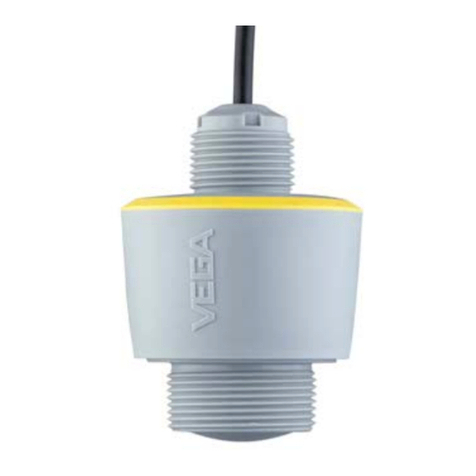
Vega
Vega VEGAPULS C 21 User manual
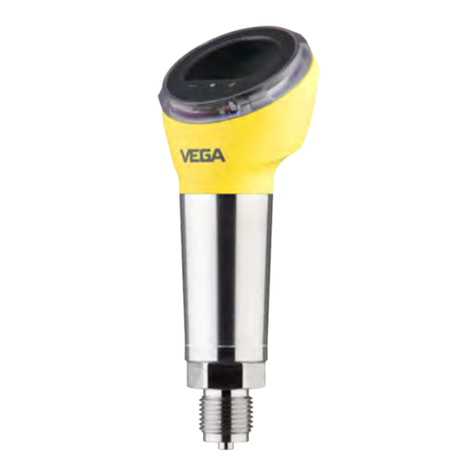
Vega
Vega VEGABAR 39 User manual
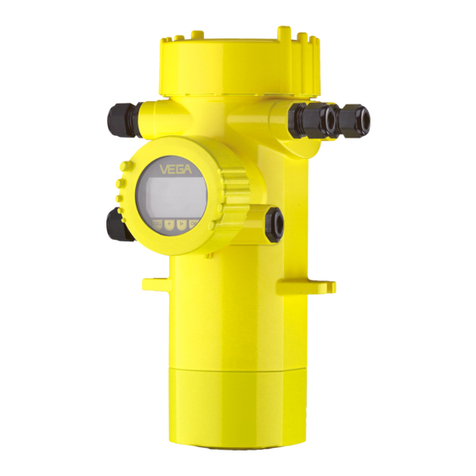
Vega
Vega MINITRAC 31 User manual

Vega
Vega VEGACAP 63 User manual

Vega
Vega VEGAPULS 69 User manual
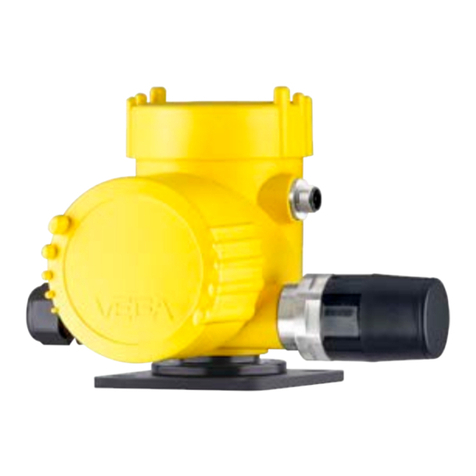
Vega
Vega PLICSMOBILE T81 User manual

Vega
Vega VEGAPULS 62 User manual
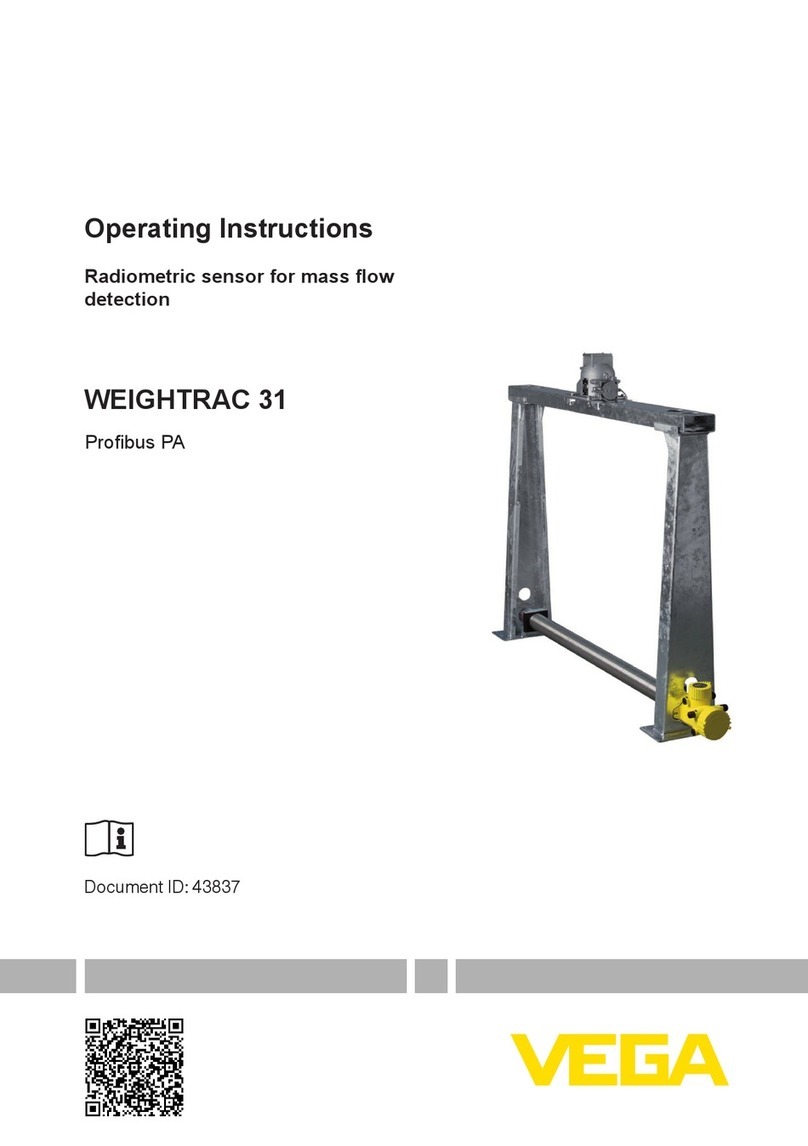
Vega
Vega WEIGHTRAC 31 User manual
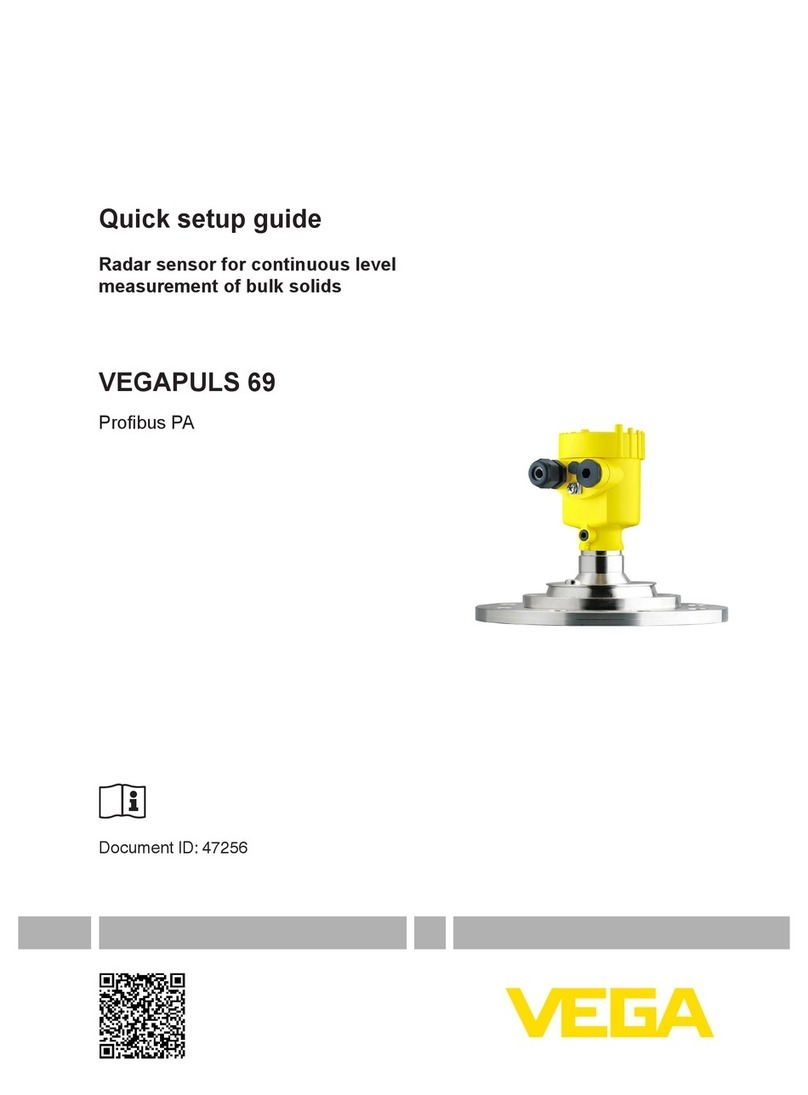
Vega
Vega VEGAPULS 69 User manual
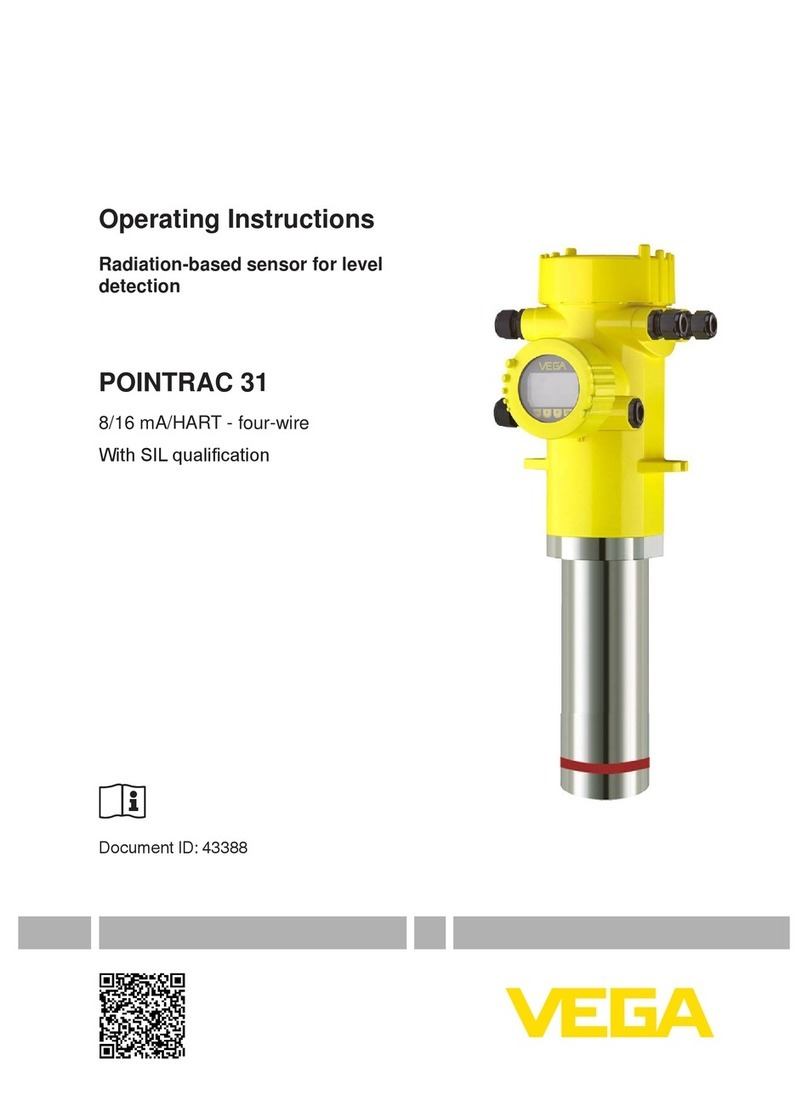
Vega
Vega POINTRAC 31 User manual
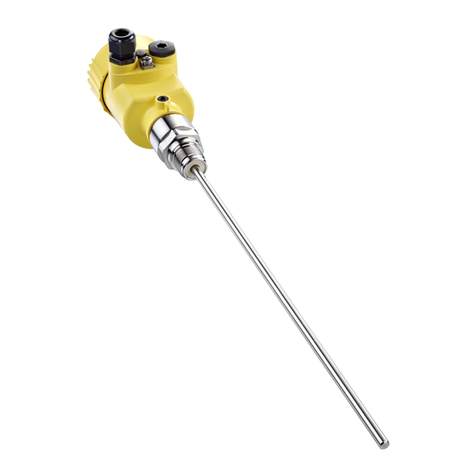
Vega
Vega VEGAFLEX 81 User manual

Vega
Vega vegaflex 83 User manual
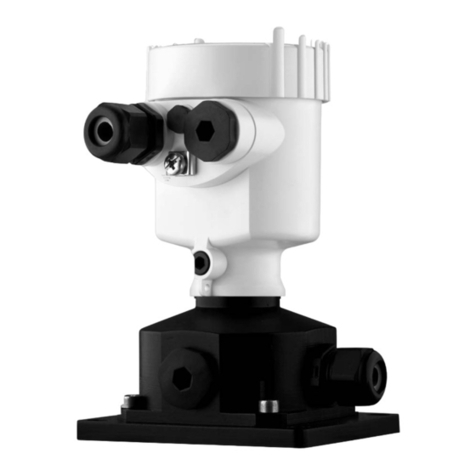
Vega
Vega VEGAVIB Wiring diagram
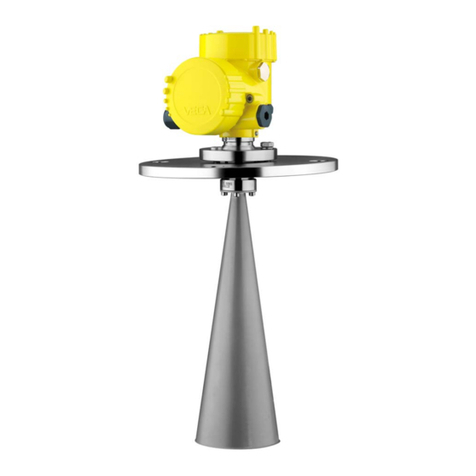
Vega
Vega VEGAPULS 68 User manual

Vega
Vega VEGAPULS 69 User manual

Vega
Vega DP-1 User manual
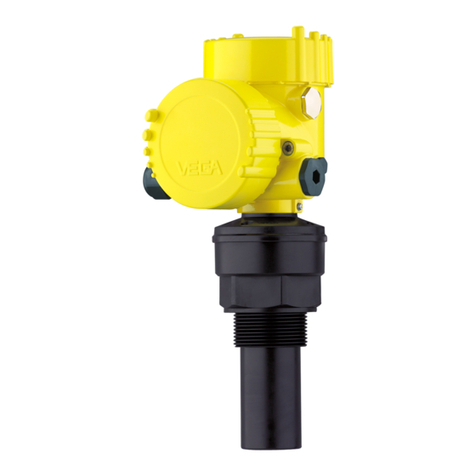
Vega
Vega VEGASON 61 User manual
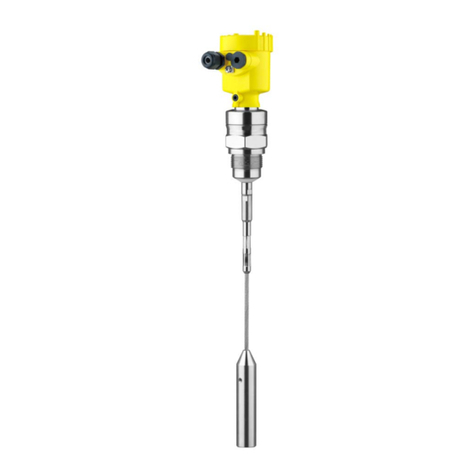
Vega
Vega VEGAFLEX 82 User manual
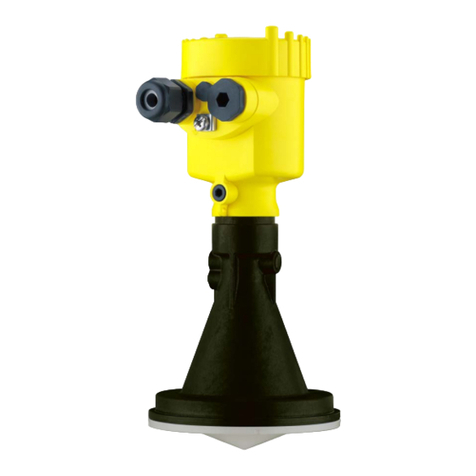
Vega
Vega VEGAPULS 61 User manual

Vega
Vega VEGAFLEX 86 User manual

